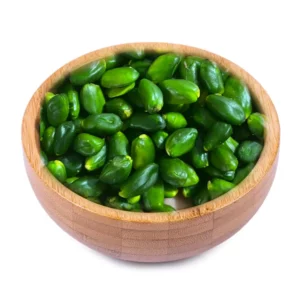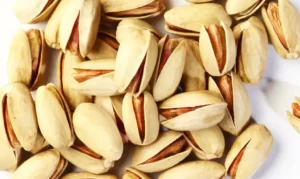Pistachio
Description
The pistachio is native to western Asia and Asia Minor, where it is still found growing in numerous hot, dry locations in Iran, Lebanon, Palestine, Syria, Iraq, India, Southern Europe, and the desert countries of Asia and Africa. in Iran, you can found the best quality pistachio in Kerman area. Iranians call the pistachio “Green Gold” because of its intense flavor and cultural popularity. Generally, the commercial pistachio varieties of Iran are “Long Pistachio” and “Round Pistachio”.
Long pistachios are Akbari, Ahmad aghai, and Badami. Round pistachios are Fandoghi, and Kale ghouchi; it is much bigger than Fandoghi.
Types
Each type is known for being slightly different in some unique way. But many people don’t realize that pistachios come in a variety of types. All the pistachios mentioned above can be processed as follows: Naturally Opened Pistachios, Mechanically Opened Pistachios, Closed Shell Pistachios. So, there are different types of pistachios in the Akam Trade market.
History
The trunk and branches of pistachio trees have gray color, and it becomes darker over the years. The root system is strong and can reach a depth of 10 feet (3 meters) and a width of 26 feet (8 meters). The leaves begin to fall in late autumn (November in many cases). The female trees that produced fruits lose their leaves first. Then, the female trees that did not bear fruits start to lose their leaves. Finally, the male pistachio trees normally lose their leaves after female trees. The bloom usually takes place during spring (April). In many cases, a great percentage of male flowers bloom far earlier than the female flowers. As a result, a great percentage of pollen can be lost, resulting in decrease of fruit set and production. Thus, some pistachio farmers collect the pollen from male flowers, they store it suitable conditions and they disperse it in the female trees once they have bloomed. This is called artificial pollination.
Contrary to other nuts, pistachios grow in clusters, like grapes. The pistachio tree bears fruit in shoots created the year before by ordinary buds. The tree has a tendency towards Alternate Bearing (producing a lot of fruits in one year and not many fruits in the following year). The pistachio tree can normally produce good yields from the 7th year of its age. Its productive life can reach 100 years or more.
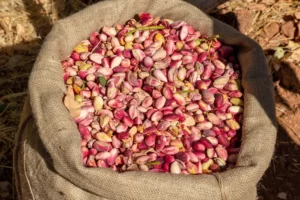
The first thing we have to do is search for natural fresh harvested pistachios. This may be more difficult than it sounds, because nearly all newly harvested pistachios are transferred to the processing units in less than 20 hours. Keep in mind that most of pistachios we can find in the market are roasted, so these seeds will definitely not sprout. In all cases, we need to find seeds that have not been processed in any way. They must be untreated, unroasted, unheated, and unsalted seeds.
Pistachios split before they are harvested. Thus, they must not fall in the ground, because they run the risk of contamination from soil microorganisms. The fruits that fall in the ground do not get harvested and they are left there as compost to the trees. Harvesting of pistachio tree begins late summer (August to mid-September in Iran), depending on the variety and the region, and lasts about 15 to 20 days. Contrary to citrus, apples and other fruit trees, all pistachio fruits in a tree do not normally mature at the same time. Consequently, harvesting takes place in 2 or 3 stages (2-3 “hands”). The first hand is usually harvested when 60-70% of the fruits have ripened.

Harvesting of pistachio trees is a labor intensive procedure when made by hand, by shaking the trees with special hand equipment. The fruits fall underneath the canopy of trees, over outstretched sails or collection nets. Then, the fruits are sorted in piles and a rough screening follows in order to remove fallen leaves, broken seeds and shoots. Immediately after sorting or maximum after 10-12 hours, they are spread out in a cool place, and the nuts should be peeled, otherwise their quality will be deteriorated.
The average budded pistachio tree usually comes into fruition in the fourth or fifth year of its life. The production at this young age usually ranges from 2,2 to 4,4 lbs. (1-2 kg) of dry nuts per tree, or 5,5 to 11 lbs. (2,5 to 5 kg) of freshly harvested fruits. For a medium production, 7-10 years are required. At this age, a fair production ranges from 13 to 22 lbs. (6 to 10 kg) dry nuts per tree or 33-55 lbs. (15-25 kg) fresh harvested fruits. When the trees go into full fruition, at 12-14 years old of age, the production of a healthy and well cared pistachio tree can reach or exceed 33 lbs. (15 kg) of dry nuts or 83 lbs. (37,5 kg) of freshly harvested fruits.
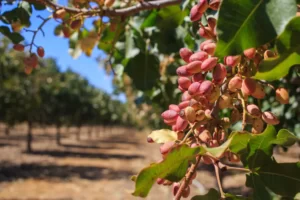

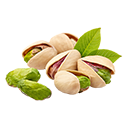 Pistachio
Pistachio Almond
Almond Walnut
Walnut Barberry
Barberry Raisins
Raisins Saffron
Saffron Jujube
Jujube Dried Fig
Dried Fig Kaloote
Kaloote Piarom
Piarom Zahedi
Zahedi Mazafati
Mazafati Estameran
Estameran Rabbi
Rabbi